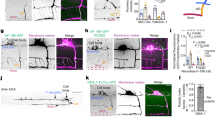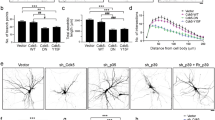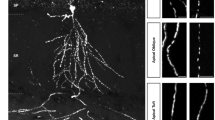Abstract
The molecular mechanisms underlying polarized sorting of proteins in neurons are poorly understood. Here we report the identification of a 16 amino-acid, dileucine-containing motif that mediates dendritic targeting in a variety of neuronal cell types in slices of rat brain. This motif is present in the carboxy (C) termini of Shal-family K+ channels and is highly conserved from C. elegans to humans. It is necessary for dendritic targeting of potassium channel Kv4.2 and is sufficient to target the axonally localized channels Kv1.3 and Kv1.4 to the dendrites. It can also mediate dendritic targeting of a non-channel protein, CD8.
This is a preview of subscription content, access via your institution
Access options
Subscribe to this journal
Receive 12 print issues and online access
$209.00 per year
only $17.42 per issue
Buy this article
- Purchase on Springer Link
- Instant access to full article PDF
Prices may be subject to local taxes which are calculated during checkout







Similar content being viewed by others
References
Doyle, D.A. et al. The structure of the potassium channel: molecular basis of K+ conduction and selectivity. Science 280, 69–77 (1998).
Veh, R.W. et al. Immunohistochemical localization of five members of the Kv1 channel subunits: contrasting subcellular locations and neuron-specific co- localizations in rat brain. Eur. J. Neurosci. 7, 2189–2205 (1995).
Smart, S.L. et al. Deletion of the K(V)1.1 potassium channel causes epilepsy in mice. Neuron 20, 809–819 (1998).
Sheng, M., Tsaur, M.L., Jan, Y.N. & Jan, L.Y. Subcellular segregation of two A-type K+ channel proteins in rat central neurons. Neuron 9, 271–284 (1992).
Baro, D.J. et al. Molecular underpinnings of motor pattern generation: differential targeting of shal and shaker in the pyloric motor system. J. Neurosci. 20, 6619–6630 (2000).
Song, W.J. et al. Somatodendritic depolarization-activated potassium currents in rat neostriatal cholinergic interneurons are predominantly of the A type and attributable to coexpression of Kv4.2 and Kv4.1 subunits. J. Neurosci. 18, 3124–3137 (1998).
Cooper, E.C., Milroy, A., Jan, Y.N., Jan, L.Y. & Lowenstein, D.H. Presynaptic localization of Kv1.4-containing A-type potassium channels near excitatory synapses in the hippocampus. J. Neurosci. 18, 965–974 (1998).
Tsunoda, S., Sun, Y., Suzuki, E. & Zuker, C. Independent anchoring and assembly mechanisms of INAD signaling complexes in Drosophila photoreceptors. J. Neurosci. 21, 150–158 (2001).
Lim, S.T., Antonucci, D.E., Scannevin, R.H. & Trimmer, J.S. A novel targeting signal for proximal clustering of the Kv2.1 K+ channel in hippocampal neurons. Neuron 25, 385–397 (2000).
Garrido, J.J. et al. Identification of an axonal determinant in the C-terminus of the sodium channel Na(v)1.2. EMBO J. 20, 5950–5961 (2001).
Burack, M.A., Silverman, M.A. & Banker, G. The role of selective transport in neuronal protein sorting. Neuron 26, 465–472 (2000).
Hunziker, W., Harter, C., Matter, K. & Mellman, I. Basolateral sorting in MDCK cells requires a distinct cytoplasmic domain determinant. Cell 66, 907–920 (1991).
Matter, K. & Mellman, I. Mechanisms of cell polarity: sorting and transport in epithelial cells. Curr. Opin. Cell Biol. 6, 545–554 (1994).
Dotti, C.G. & Simons, K. Polarized sorting of viral glycoproteins to the axon and dendrites of hippocampal neurons in culture. Cell 62, 63–72 (1990).
Casanova, J.E., Apodaca, G. & Mostov, K.E. An autonomous signal for basolateral sorting in the cytoplasmic domain of the polymeric immunoglobulin receptor. Cell 66, 65–75 (1991).
Matter, K., Yamamoto, E.M. & Mellman, I. Structural requirements and sequence motifs for polarized sorting and endocytosis of LDL and Fc receptors in MDCK cells. J. Cell Biol. 126, 991–1004 (1994).
Odorizzi, G. & Trowbridge, I.S. Structural requirements for basolateral sorting of the human transferrin receptor in the biosynthetic and endocytic pathways of Madin-Darby canine kidney cells. J. Cell Biol. 137, 1255–1264 (1997).
Kundu, A. & Nayak, D.P. Analysis of the signals for polarized transport of influenza virus (A/WSN/33) neuraminidase and human transferrin receptor, type II transmembrane proteins. J. Virol. 68, 1812–1818 (1994).
Jareb, M. & Banker, G. The polarized sorting of membrane proteins expressed in cultured hippocampal neurons using viral vectors. Neuron 20, 855–867 (1998).
Stowell, J.N. & Craig, A.M. Axon/dendrite targeting of metabotropic glutamate receptors by their cytoplasmic carboxy-terminal domains [see comments]. Neuron 22, 525–536 (1999).
Francesconi, A. & Duvoisin, R.M. Alternative splicing unmasks dendritic and axonal targeting signals in metabotropic glutamate receptor 1. J. Neurosci. 22, 2196–2205 (2002).
Ruberti, F. & Dotti, C.G. Involvement of the proximal C terminus of the AMPA receptor subunit GluR1 in dendritic sorting. J. Neurosci. 20, RC78 (2000).
Arnold, D., Feng, L., Kim, J. & Heintz, N. A strategy for the analysis of gene expression during neural development. Proc. Natl. Acad. Sci. USA 91, 9970–9974 (1994).
Moriyoshi, K., Richards, L.J., Akazawa, C., O'Leary, D.D. & Nakanishi, S. Labeling neural cells using adenoviral gene transfer of membrane-targeted GFP. Neuron 16, 255–260 (1996).
Yellen, G. The voltage-gated potassium channels and their relatives. Nature 419, 35–42 (2002).
Letourneur, F. & Klausner, R.D. A novel di-leucine motif and a tyrosine-based motif independently mediate lysosomal targeting and endocytosis of CD3 chains. Cell 69, 1143–1157 (1992).
Matter, K., Hunziker, W. & Mellman, I. Basolateral sorting of LDL receptor in MDCK cells: the cytoplasmic domain contains two tyrosine-dependent targeting determinants. Cell 71, 741–753 (1992).
Craig, A.M., Wyborski, R.J. & Banker, G. Preferential addition of newly synthesized membrane protein at axonal growth cones. Nature 375, 592–594 (1995).
Hoffman, D.A., Magee, J.C., Colbert, C.M. & Johnston, D. K+ channel regulation of signal propagation in dendrites of hippocampal pyramidal neurons. Nature 387, 869–875 (1997).
Hoffman, D.A. & Johnston, D. Downregulation of transient K+ channels in dendrites of hippocampal CA1 pyramidal neurons by activation of PKA and PKC. J. Neurosci. 18, 3521–3528 (1998).
Ohno, H. et al. Interaction of tyrosine-based sorting signals with clathrin-associated proteins. Science 269, 1872–1875 (1995).
Rapoport, I., Chen, Y.C., Cupers, P., Shoelson, S.E. & Kirchhausen, T. Dileucine-based sorting signals bind to the beta chain of AP-1 at a site distinct and regulated differently from the tyrosine-based motif binding site. EMBO J. 17, 2148–2155 (1998).
Dwyer, N.D., Adler, C.E., Crump, J.G., L'Etoile, N.D. & Bargmann, C.I. Polarized dendritic transport and the AP-1 mu1 clathrin adaptor UNC-101 localize odorant receptors to olfactory cilia. Neuron 31, 277–287 (2001).
Nakagawa, T. et al. A novel motor, KIF13A, transports mannose-6-phosphate receptor to plasma membrane through direct interaction with AP-1 complex. Cell 103, 569–581 (2000).
Hanlon, D.W., Yang, Z. & Goldstein, L.S. Characterization of KIFC2, a neuronal kinesin superfamily member in mouse. Neuron 18, 439–451 (1997).
Saito, N. et al. KIFC2 is a novel neuron-specific C-terminal type kinesin superfamily motor for dendritic transport of multivesicular body-like organelles. Neuron 18, 425–438 (1997).
Setou, M., Nakagawa, T., Seog, D.H. & Hirokawa, N. Kinesin superfamily motor protein KIF17 and mLin-10 in NMDA receptor-containing vesicle transport. Science 288, 1796–1802 (2000).
Marszalek, J.R., Weiner, J.A., Farlow, S.J., Chun, J. & Goldstein, L.S. Novel dendritic kinesin sorting identified by different process targeting of two related kinesins: KIF21A and KIF21B. J. Cell Biol. 145, 469–479 (1999).
Setou, M. et al. Glutamate-receptor-interacting protein GRIP1 directly steers kinesin to dendrites. Nature 417, 83–87 (2002).
Arnold, D.B. & Clapham, D.E. Molecular determinants for subcellular localization of PSD-95 with an interacting K+ channel. Neuron 23, 149–157 (1999).
Serodio, P. & Rudy, B. Differential expression of Kv4 K+ channel subunits mediating subthreshold transient K+ (A-type) currents in rat brain. J. Neurophysiol. 79, 1081–1091 (1998).
Whitworth, T.L. & Quick, M.W. Substrate-induced regulation of gamma-aminobutyric acid transporter trafficking requires tyrosine phosphorylation. J. Biol. Chem. 276, 42932–42937 (2001).
Koren, G., Liman, E.R., Logothetis, D.E., Nadal-Ginard, B. & Hess, P. Gating mechanism of a cloned potassium channel expressed in frog oocytes and mammalian cells. Neuron 4, 39–51 (1990).
Acknowledgements
We thank D. Liu for technical assistance, G. Banker for the CD8 expression construct, K. Moriyoshi for pCA–GAP–GFP and C-P. Ko and S. Bottjer for helpful suggestions on the manuscript. This work was supported by National Institutes of Health grants NS41963 (D.B.A.) and DC04213 (E.R.L.) and a grant from the Whitehall foundation (D.B.A.).
Author information
Authors and Affiliations
Corresponding author
Ethics declarations
Competing interests
The authors declare no competing financial interests.
Rights and permissions
About this article
Cite this article
Rivera, J., Ahmad, S., Quick, M. et al. An evolutionarily conserved dileucine motif in Shal K+ channels mediates dendritic targeting. Nat Neurosci 6, 243–250 (2003). https://doi.org/10.1038/nn1020
Received:
Accepted:
Published:
Issue Date:
DOI: https://doi.org/10.1038/nn1020
This article is cited by
-
Transient photocurrents in a subthreshold evidence accumulator accelerate perceptual decisions
Nature Communications (2023)
-
Structural basis of gating modulation of Kv4 channel complexes
Nature (2021)
-
Central Targeting of Channelrhodopsin2 by the Motif of Potassium Channel Kv2.1 Can be Altered Due to Overexpression of the Construct
BioNanoScience (2021)
-
The cellular mechanisms that maintain neuronal polarity
Nature Reviews Neuroscience (2016)
-
Myosin-dependent targeting of transmembrane proteins to neuronal dendrites
Nature Neuroscience (2009)



